Ionic strength effects on amyloid formation by amylin are a complicated interplay among Debye screening, ion selectivity, and Hofmeister effects
- PMID: 23016872
- PMCID: PMC3753197
- DOI: 10.1021/bi300574r
Ionic strength effects on amyloid formation by amylin are a complicated interplay among Debye screening, ion selectivity, and Hofmeister effects
Abstract
Amyloid formation plays a role in a wide range of human diseases. The rate and extent of amyloid formation depend on solution conditions, including pH and ionic strength. Amyloid fibrils often adopt structures with parallel, in-register β-sheets, which generate quasi-infinite arrays of aligned side chains. These arrangements can lead to significant electrostatic interactions between adjacent polypeptide chains. The effect of ionic strength and ion composition on the kinetics of amyloid formation by islet amyloid polypeptide (IAPP) is examined. IAPP is a basic 37-residue polypeptide responsible for islet amyloid formation in type 2 diabetes. Poisson-Boltzmann calculations revealed significant electrostatic repulsion in a model of the IAPP fibrillar state. The kinetics of IAPP amyloid formation are strongly dependent on ionic strength, varying by a factor of >10 over the range of 20-600 mM NaCl at pH 8.0, but the effect is not entirely due to Debye screening. At low ionic strengths, the rate depends strongly on the identity of the anion, varying by a factor of nearly 4, and scales with the electroselectivity series, implicating anion binding. At high ionic strengths, the rate varies by only 8% and scales with the Hofmeister series. At intermediate ionic strengths, no clear trend is detected, likely because of the convolution of different effects. The effects of salts on the growth phase and lag phase of IAPP amyloid formation are strongly correlated. At pH 5.5, where the net charge on IAPP is higher, the effect of different anions scales with the electroselectivity series at all salt concentrations.
Figures


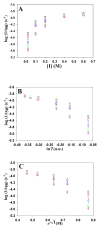


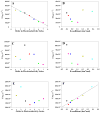
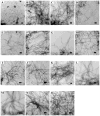



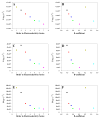
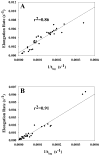
Similar articles
-
Mutational analysis of the ability of resveratrol to inhibit amyloid formation by islet amyloid polypeptide: critical evaluation of the importance of aromatic-inhibitor and histidine-inhibitor interactions.Biochemistry. 2015 Jan 27;54(3):666-76. doi: 10.1021/bi501016r. Epub 2015 Jan 15. Biochemistry. 2015. PMID: 25531836 Free PMC article.
-
Role of lysine residue of islet amyloid polypeptide in fibril formation, membrane binding, and inhibitor binding.Biochimie. 2020 Oct;177:153-163. doi: 10.1016/j.biochi.2020.08.012. Epub 2020 Aug 26. Biochimie. 2020. PMID: 32860895
-
Islet amyloid and type 2 diabetes: from molecular misfolding to islet pathophysiology.Biochim Biophys Acta. 2001 Nov 29;1537(3):179-203. doi: 10.1016/s0925-4439(01)00078-3. Biochim Biophys Acta. 2001. PMID: 11731221 Review.
-
Protein Glycation by Glyoxal Promotes Amyloid Formation by Islet Amyloid Polypeptide.Biophys J. 2019 Jun 18;116(12):2304-2313. doi: 10.1016/j.bpj.2019.05.013. Epub 2019 May 21. Biophys J. 2019. PMID: 31155148 Free PMC article.
-
Islet amyloid: from fundamental biophysics to mechanisms of cytotoxicity.FEBS Lett. 2013 Apr 17;587(8):1106-18. doi: 10.1016/j.febslet.2013.01.046. Epub 2013 Feb 1. FEBS Lett. 2013. PMID: 23380070 Free PMC article. Review.
Cited by
-
Hexametaphosphate, a Common Food Additive, Aggregated the Hen Egg White Lysozyme.ACS Omega. 2023 Nov 10;8(46):44086-44092. doi: 10.1021/acsomega.3c06210. eCollection 2023 Nov 21. ACS Omega. 2023. PMID: 38027328 Free PMC article.
-
The Route from the Folded to the Amyloid State: Exploring the Potential Energy Surface of a Drug-Like Miniprotein.Chemistry. 2020 Feb 11;26(9):1968-1978. doi: 10.1002/chem.201903826. Epub 2019 Dec 27. Chemistry. 2020. PMID: 31647140 Free PMC article.
-
Analysis of Baboon IAPP Provides Insight into Amyloidogenicity and Cytotoxicity of Human IAPP.Biophys J. 2020 Mar 10;118(5):1142-1151. doi: 10.1016/j.bpj.2019.12.027. Epub 2020 Jan 3. Biophys J. 2020. PMID: 32105649 Free PMC article.
-
Cryo-Electron Microscopy Provides Mechanistic Insights into Solution-Dependent Polymorphism and Cross-Aggregation Phenomena of the Human and Rat Islet Amyloid Polypeptides.Biochemistry. 2025 Jun 17;64(12):2583-2595. doi: 10.1021/acs.biochem.5c00042. Epub 2025 May 26. Biochemistry. 2025. PMID: 40417836 Free PMC article.
-
On the lag phase in amyloid fibril formation.Phys Chem Chem Phys. 2015 Mar 28;17(12):7606-18. doi: 10.1039/c4cp05563b. Phys Chem Chem Phys. 2015. PMID: 25719972 Free PMC article. Review.
References
-
- Abedini A, Raleigh DP. Destabilization of human IAPP amyloid fibrils by proline mutations outside of the putative amyloidogenic domain: is there a critical amyloidogenic domain in human IAPP. J Mol Biol. 2006;355:274–281. - PubMed
-
- Maurer-Stroh S, Debulpaep M, Kuemmerer N, Lopez M, Martins I, Reumers J, et al. Exploring the sequence determinants of amyloid structure using position-specific scoring matrices. Nat Methods. 2010;7:237–242. - PubMed
-
- Moriarty DF, Raleigh DP. Effects of sequential proline substitutions on amyloid formation by human amylin 20–29. Biochemistry (Mosc) 1999;38:1811–1818. - PubMed
-
- Nerelius C, Fitzen M, Johansson J. Amino acid sequence determinants and molecular chaperones in amyloid fibril formation. Biochem Biophys Res Comm. 2010;396:2–6. - PubMed
-
- Tjernberg L, Hosia W, Bark N, Thyberg J, Johansson J. Charge attraction and beta propensity are necessary for amyloid fibril formation from tetrapeptides. J Biol Chem. 2002;277:43243–43246. - PubMed

